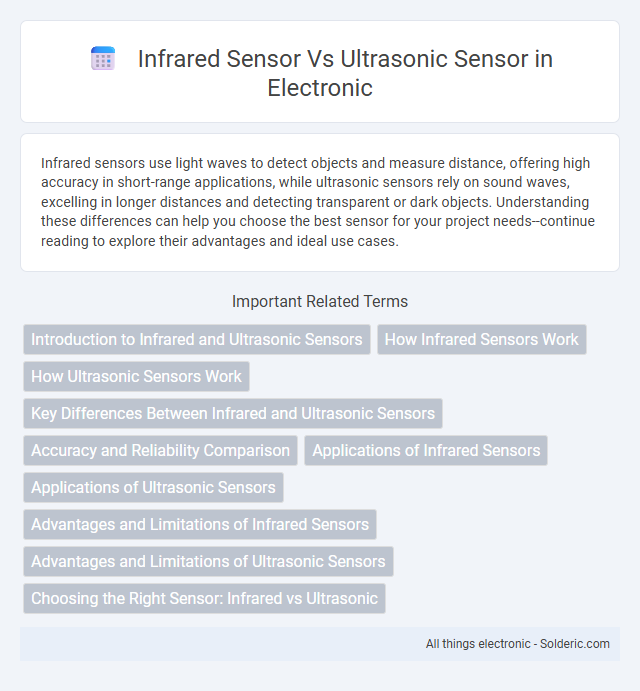Infrared sensors use light waves to detect objects and measure distance, offering high accuracy in short-range applications, while ultrasonic sensors rely on sound waves, excelling in longer distances and detecting transparent or dark objects. Understanding these differences can help you choose the best sensor for your project needs--continue reading to explore their advantages and ideal use cases.
Comparison Table
| Feature | Infrared Sensor | Ultrasonic Sensor |
|---|---|---|
| Operating Principle | Emits and detects infrared light reflection | Emits and detects ultrasonic sound waves reflection |
| Detection Range | Short to medium (typically 2-30 cm) | Medium to long (typically 2 cm to 4-5 meters) |
| Accuracy | Good at close range, affected by surface color and material | High accuracy over distance, less affected by color or transparency |
| Environmental Sensitivity | Sensitive to ambient light and reflective surfaces | Unaffected by lighting, but affected by soft materials and irregular shapes |
| Response Time | Fast response | Moderate response |
| Cost | Low cost | Moderate cost |
| Applications | Object detection, proximity sensing, line following robots | Distance measurement, obstacle avoidance, liquid level sensing |
Introduction to Infrared and Ultrasonic Sensors
Infrared sensors detect objects by measuring emitted or reflected infrared light, ideal for short-range applications and detecting heat signatures. Ultrasonic sensors emit high-frequency sound waves and measure the time it takes for echoes to return, enabling precise distance measurement over longer ranges. Your choice depends on factors like detection range, environmental conditions, and the nature of the target object.
How Infrared Sensors Work
Infrared sensors detect objects by emitting infrared light and measuring the reflected signal intensity to determine proximity or presence. These sensors rely on the principle that different surfaces reflect infrared light inconsistently, allowing precise detection based on the amount of reflected radiation. Understanding how infrared sensors work helps you choose the right technology for applications requiring short-range object detection or motion sensing.
How Ultrasonic Sensors Work
Ultrasonic sensors emit high-frequency sound waves that reflect off objects and return to the sensor, allowing it to measure distance based on the time delay between transmission and reception. These sensors typically operate at frequencies around 40 kHz, which are inaudible to humans but effective for precise distance measurement in various environments. Their ability to detect transparent or dark objects and function reliably under different lighting conditions distinguishes them from infrared sensors.
Key Differences Between Infrared and Ultrasonic Sensors
Infrared sensors detect objects by measuring the reflection of infrared light waves, making them ideal for short-range applications and detecting surface temperature variation. Ultrasonic sensors use high-frequency sound waves to measure the distance to an object, providing accurate long-range detection regardless of color or transparency. Infrared sensors are generally more affected by ambient light and surface properties, while ultrasonic sensors perform better in diverse environmental conditions and can detect soft or transparent materials.
Accuracy and Reliability Comparison
Infrared sensors offer high accuracy in short-range object detection but are prone to false readings under ambient light interference, reducing reliability in outdoor environments. Ultrasonic sensors provide consistent accuracy over longer distances and perform reliably regardless of lighting conditions, making them suitable for diverse applications. The choice between infrared and ultrasonic sensors depends on the specific accuracy requirements and environmental factors impacting sensor reliability.
Applications of Infrared Sensors
Infrared sensors are widely used in motion detection systems, remote controls, and temperature measurement applications due to their ability to detect heat emitted by objects. They are essential in security systems for intruder detection and in industrial automation for monitoring equipment and processes. Infrared sensors also play a critical role in healthcare devices, such as pulse oximeters, by sensing blood flow and body temperature accurately.
Applications of Ultrasonic Sensors
Ultrasonic sensors are widely used in applications such as distance measurement, object detection, and level sensing in industrial automation, robotics, and automotive parking assistance systems. These sensors provide accurate and reliable results by emitting sound waves and measuring the echo time, making them ideal for environments where optical sensors like infrared might fail due to dust, fog, or color variations. Your projects benefit from ultrasonic sensors' versatility and robustness in complex detection and ranging tasks.
Advantages and Limitations of Infrared Sensors
Infrared sensors offer advantages such as low cost, compact size, and the ability to detect objects without physical contact by measuring emitted or reflected infrared radiation. They perform well in detecting nearby objects and can function effectively in low-light or dark environments. However, infrared sensors are limited by their susceptibility to interference from ambient light, reduced range compared to ultrasonic sensors, and difficulties detecting transparent or highly reflective surfaces.
Advantages and Limitations of Ultrasonic Sensors
Ultrasonic sensors offer advantages such as longer detection ranges up to several meters, high accuracy in distance measurement, and effective performance in various lighting conditions, making them ideal for obstacle detection and level measurement. However, limitations include sensitivity to environmental factors like temperature and humidity, potential interference from ultrasonic noise, and reduced effectiveness on soft or uneven surfaces that absorb sound waves. Despite these drawbacks, their robustness and versatility make ultrasonic sensors essential in automotive, robotics, and industrial automation.
Choosing the Right Sensor: Infrared vs Ultrasonic
Infrared sensors excel in detecting objects with high precision at short ranges and are highly effective in environments with minimal ambient light, making them ideal for proximity sensing and obstacle detection within a few centimeters. Ultrasonic sensors offer longer range detection by using sound waves to measure distance, performing well in various lighting conditions but potentially affected by materials that absorb or scatter sound. Your choice between infrared and ultrasonic sensors should consider factors like detection range, environmental conditions, and the sensor's response to surface materials for optimal performance in applications.
infrared sensor vs ultrasonic sensor Infographic

 solderic.com
solderic.com